Selective Aerobic Oxidation of P-Methoxytoluene by Co(II)-Promoted NHPI Incorporated into Cross-Linked Copolymer Structure
Abstract
:1. Introduction
2. Results and Discussion
2.1. Effect of Composition of Copolymer Catalysts on Activity in Aerobic Oxidation of PMT
2.2. Mechanism of Aerobic Oxidation of PMT over Copolymer Catalysts
2.3. Stability of Copolymer Catalysts during Aerobic Oxidation of PMT
3. Materials and Methods
3.1. Synthesis
3.1.1. Synthesis of Functional Monomer (VDPE)
3.1.2. Copolymerization of VDPE, DVB and Styrene
3.2. Characterization
3.3. Catalytic Tests
4. Conclusions
Supplementary Materials
Author Contributions
Funding
Institutional Review Board Statement
Informed Consent Statement
Data Availability Statement
Conflicts of Interest
References
- Wang, L.; Zhang, Y.; Du, R.; Yuan, H.; Wang, Y.; Yao, J.; Li, H. Selective One-Step Aerobic Oxidation of Cyclohexane to ϵ-Caprolactone Mediated by N-Hydroxyphthalimide (NHPI). ChemCatChem 2019, 11, 423–427. [Google Scholar] [CrossRef] [Green Version]
- Melone, L.; Franchi, P.; Lucarini, M.; Punta, C. Sunlight Induced Oxidative Photoactivation of N-Hydroxyphthalimide Mediated by Naphthalene Imides. Adv. Synth. Catal. 2013, 355, 3210–3220. [Google Scholar] [CrossRef]
- Tong, X.; Xu, J.; Miao, H. Highly Efficient and Metal-Free Aerobic Hydrocarbons Oxidation Process by an o-Phenanthroline-Mediated Organocatalytic System. Adv. Synth. Catal. 2005, 347, 1953–1957. [Google Scholar] [CrossRef]
- Kuznetsova, N.I.; Kuznetsova, L.I.; Yakovina, O.A.; Karmadonova, I.E.; Balzhinimaev, B.S. An Improved Catalytic Performance of Fe(III)-promoted NHPI in the Oxidation of Hydrocarbons to Hydroperoxides. Catal. Lett. 2020, 150, 1020–1027. [Google Scholar] [CrossRef]
- Figiel, P.J.; Sobczak, J.M. Mechanistic Investigation of the Catalytic System Based on N-Hydroxy-Phthalimide with Vanadium co-Catalysts for Aerobic Oxidation of Alcohols with Dioxygen. J. Catal. 2009, 263, 167–172. [Google Scholar] [CrossRef]
- Zheng, G.; Liu, C.; Wang, Q.; Wang, M.; Yang, G. Metal-Free: An Efficient and Selective Catalytic Aerobic Oxidation of Hydrocarbons with Oxime and N-Hydroxyphthalimide. Adv. Synth. Catal. 2009, 351, 2638–2642. [Google Scholar] [CrossRef]
- Centi, G.; Perathoner, S. Methods and tools of sustainable industry chemistry: Catalysis. In Sustainable Industrial Chemistry; Cavani, F., Centi, G., Perathoner, S., Trifiro, F., Eds.; Wiley-VCH: Weinheim, Germany, 2009; pp. 73–188. [Google Scholar]
- Weissermel, K.; Arpe, H.J. Oxidation Products of Xylene and Naphthalene. In Industrial Organic Chemistry, 3rd ed.; Wiley-VCH: Weinheim, Germany, 1997; pp. 385–404. [Google Scholar]
- Sheehan, R.J. Terephthalic acid, dimethyl terephthalate, and isophthalic acid. In Ullmann’s Encyclopedia of Industrial Chemistry, 7th ed.; Wiley-VCH: Weinheim, Germany, 2012; Volume 36. [Google Scholar]
- Melone, L.; Gambarotii, C.; Prosperini, S.; Pastori, N.; Recupero, F.; Punta, C. Hydroperoxidation of Tertiary Alkylaromatics Catalyzed By N-Hydroxyphthalimide and Aldehydes under Mild Condition. Adv. Synth. Catal. 2011, 353, 147–154. [Google Scholar] [CrossRef]
- Hock, H.; Lang, S. Autoxydation von Kohlenwasserstoffen, IX. Mitteil.: Über Peroxyde von Benzol-Derivaten. Ber. Dtsch. Chem. Ges. 1944, 77, 257–264. [Google Scholar] [CrossRef]
- Ishii, Y.; Sakaguchi, S.; Obora, Y. Aerobic oxidations and related reactions catalyzed by N-hydroxyphthalimide. In Modern Oxidation Methods; Bäckvall, J.-E., Ed.; Willey-VCH: Weinheim, Germany, 2010; pp. 187–240. [Google Scholar]
- Ishii, Y.; Sakaguchi, S. Recent progress in aerobic oxidation of hydrocarbons by N-hydroxyimide. Catal. Today 2006, 117, 105–113. [Google Scholar] [CrossRef]
- Ishii, Y.; Iwahama, T.; Sakaguchi, S.; Nakayama, K.; Nishiyama, Y. Alkane Oxidation with Molecular Oxygen Using a New Efficient Catalytic System: N-Hydroxyphthalimide (NHPI) Combined with Co(acac)n (n = 2 or 3). J. Org. Chem. 1996, 61, 4520–4526. [Google Scholar] [CrossRef] [PubMed]
- Daicel Chemical Industries, LTD. Environment and Safety Report, Responsible Care Activities/Social Activities. 2006. Available online: https://www.daicel.com/en/sustainability/pdf/library/ar2006e.pdf (accessed on 17 November 2021).
- Daicel Chemical Industries, LTD. Environment and Safety Report. 2008. Available online: https://www.daicel.com/en/sustainability/pdf/library/ar2008e.pdf (accessed on 17 November 2021).
- Yoshino, Y.; Hayashi, Y.; Iwahama, T.; Sakaguchi, S.; Ishii, Y. Catalytic Oxidation of Alkylbenzenes with Molecular Oxygen under Normal Pressure and Temperature by N-Hydroxyphthalimide Combined with Co(OAc)2. J. Org. Chem. 1997, 62, 6810–6813. [Google Scholar] [CrossRef]
- Yoshino, Y.; Iwahama, T.; Sakaguchi, S.; Ishii, Y. A New Strategy for the Preparation of Terephthalic Acid by the Aerobic Oxidation of p-Xylene using N-Hydroxyphthalimide as a Catalyst. Adv. Synth. Catal. 2001, 343, 220–225. [Google Scholar]
- Coseri, S.; Biliuta, G.; Simionescu, B.C. Selective oxidation of cellulose, mediated by N-hydroxyphthalimide, under metal-free environment. Polym. Chem. 2018, 9, 961–967. [Google Scholar] [CrossRef]
- Kasperczyk, K.; Orlinska, B.; Witek, E.; Łątka, P.; Zawadiak, J.; Proniewicz, L. Polymer-Supported N-Hydroxyphthalimide as Catalyst for Toluene and p-Methoxytoluene Aerobic Oxidation. Catal. Lett. 2015, 145, 1856–1867. [Google Scholar] [CrossRef]
- Huang, J.-L.; Gao, B.-J.; Yang, X.-L. Catalytic Performance of N-Hydroxyphthalimide-immobilized Cross-linked Polystyrene Microspheres in Oxidation of Toluene and Cyclohexanol. Chin. J. Process Eng. 2014, 4, 683–688. [Google Scholar]
- Yang, D.-H.; Zhao, W.-J.; Gao, L. Study of Catalyzed Oxidation of Cyclohexane in a Solvent-free System using a unique Combination of two Heterogeneous Catalysts. J. Mol. Catal. 2008, 6, 513–518. [Google Scholar]
- Yang, X.-L.; Gao, B.-J.; Huang, J.-L. Preparation of N-Hydroxyphthalimide Catalyst Supported on Polymer Microspheres and Preliminary Study on Its Catalytic Oxidation Performance. J. Funct. Polym. 2014, 27, 278–284. [Google Scholar]
- Gao, B.; Bi, C. Some Catalytic Characteristics of Compositional Catalysts of Immobilized N-Hydroxyphthalimide and Metal Salts in Aerobic Oxidation of 1-Phenylethanol. Catal. Commun. 2018, 115, 6–11. [Google Scholar] [CrossRef]
- Koguchi, S.; Kitazume, T. Synthetic Utilities of Ionic Liquid-Supported NHPI Complex. Tetrahedron Lett. 2006, 47, 2797–2801. [Google Scholar] [CrossRef]
- Su, S.; Giguere, J.R.; Schaus, S.E.; Parco, J.A. Synthesis of Complex Alkoxyamines Using a Polymer-Supported N-Hydroxyphthalimide. Tetrahedron 2004, 60, 8645–8657. [Google Scholar] [CrossRef]
- Maillard, L.T.; Benohound, M.; Durand, P.; Badet, B. A New Supported Reagent for the Parallel Synthesis of Primary and Secondary O-Alkyl Hydroxylamines through a Base-Catalyzed Mitsunobu Reaction. J. Org. Chem. 2005, 70, 6303–6321. [Google Scholar] [CrossRef]
- Culica, M.E.; Kasperczyk, K.; Baron, R.I.; Biliuta, G.; Macsim, A.M.; Lazea-Stoyanova, A.; Orlińska, B.; Coseri, S. Recyclable Polymer-Supported N-Hydroxyphthalimide Catalysts for Selective Oxidation of Pullulan. Materials 2019, 12, 3585. [Google Scholar] [CrossRef] [PubMed] [Green Version]
- Li, X.; Guo, L.; He, P.; Yuan, X.; Jiao, F. Co-SBA-15-Immobilized NDHPI as a New Composite Catalyst for Toluene Aerobic Oxidation. Catal. Lett. 2017, 147, 856–864. [Google Scholar] [CrossRef]
- Hermans, H.; Deun, J.V.; Houthoofd, K.; Peeters, J.; Jacobs, P.A. Silica-immobilized N-hydroxyphthalimide: An efficient heterogeneous autoxidation catalyst. J. Catal. 2007, 251, 204–212. [Google Scholar] [CrossRef]
- Hosseinzadeh, R.; Mavvaji, M.; Tajbakhsh, M.; Lasemi, Z. Synthesis and characterization of N-hydroxyphthalimide immobilized on SiO2-coated Fe3O4 nanoparticles as magnetic catalyst for oxidation of benzyl alcohols and hydrocarbons. J. Iran. Chem. Soc. 2018, 15, 893–904. [Google Scholar] [CrossRef]
- Dobras, G.; Kasperczyk, K.; Jurczyk, S.; Orlińska, B. N-Hydroxyphthalimide Supported on Silica Coated with Ionic Liquids Containing CoCl2 (SCILLs) as New Catalytic System for Solvent-Free Ethylbenzene Oxidation. Catalysts 2020, 10, 252. [Google Scholar] [CrossRef] [Green Version]
- Hosseinzadeh, R.; Mavvaji, M.; Tajbakhsh, M.; Lasemi, Z. Synthesis and Characterization of N-Hydroxyphthalimide Immobilized on NaY Nano-Zeolite as a Novel and Efficient Catalyst for the Selective Oxidation of Hydrocarbons and Benzyl Alcohols. React. Kinet. Mech. Catal. 2018, 124, 839–855. [Google Scholar] [CrossRef]
- Wang, M.; Liang, G.; Wang, Y.; Fan, T.; Yuan, B.; Liu, M.; Yin, Y.; Li, L. Merging N-hydroxyphthalimide into Metal−Organic Frameworks for Highly Efficient and Environmentally Benign Aerobic Oxidation. Chem. A Eur. J. 2021, 2, 9674–9685. [Google Scholar] [CrossRef]
- Blandez, J.F.; Navalon, S.; Alvaro, M.; Garcia, H. N-hydroxyphthalimide anchored on diamond nanoparticles as selective heterogeneous metal-free oxidation catalyst of benzylic hydrocarbons and cyclic alkenes by molecular O2. ChemCatChem 2018, 10, 34–41. [Google Scholar] [CrossRef]
- Luo, J.; Peng, F.; Yu, H.; Wang, H.; Zheng, W. Aerobic Liquid-Phase Oxidation of Ethylbenzene to Acetophenone Catalyzed by Carbon Nanotubes. ChemCatChem 2013, 5, 1578–1586. [Google Scholar] [CrossRef]
- Zhou, M.; Li, X.X.; Bao, L.; Yuan, X.; Luo, H.A. A new method for immobilization of NDHPI on SBA-15 carrier used as catalyst for selective oxidation of toluene. Catal. Lett. 2016, 146, 383–390. [Google Scholar] [CrossRef]
- Xu, J.; Shi, G.; Liang, Y.; Lu, Q.; Ji, L. Selective aerobic oxidation of toluene to benzaldehyde catalyzed by covalently anchored N-hydroxyphthalimide and cobaltous ions. Mol. Catal. 2020, 503, 111440–111450. [Google Scholar] [CrossRef]
- Shi, G.; Lu, Q.; Xu, J.; Wang, J.; Ji, L. Co-immobilization of N-hydroxyphthalimide and cobaltous ions as a recyclable catalyst for selective aerobic oxidation of toluene to benzaldehyde. J. Environ. Chem. Eng. 2021, 9, 106234–106244. [Google Scholar] [CrossRef]
- Wu, Z.; Zhang, K.; Li, X.; Hai, G.; Huang, X.; Wang, G. Conjugated polymer coated MIL-125(Ti) as an efficient photocatalyst for selective oxidation of benzylic C–H bond under visible light. Appl. Surf. Sci. 2021, 555, 149732. [Google Scholar] [CrossRef]
- Pokutsa, A.; Ohkubo, K.; Zaborovski, A.; Bloniarz, P. UV-induced oxygenation of toluene enhanced by Co (acac)2/9-mesityl-10-methylacridinium ion/N-hydroxyphthalimide tandem. Asia-Pac. J. Chem. Eng. 2021, e2714. [Google Scholar] [CrossRef]
- Rafiee, M.; Karimi, B.; Alizadeh, S. Mechanistic Study of the Electrocatalytic Oxidation of Alcohols by TEMPO and NHPI. ChemElectroChem 2014, 1, 455–462. [Google Scholar] [CrossRef]
- Mo, Y.; Jensen, K.F. Continuous N-Hydroxyphthalimide (NHPI)-Mediated Electrochemical Aerobic Oxidation of Benzylic C@H Bonds. Chem. Eur. J. 2018, 24, 10260–10265. [Google Scholar] [CrossRef]
- Chen, W.; Tang, H.; Wang, W.; Fu, Q.; Luo, J. Catalytic Aerobic Dehydrogenation of N-Heterocycles by N-Hydoxyphthalimide. Adv. Synth. Catal. 2020, 362, 3905–3911. [Google Scholar] [CrossRef]
- Lardy, S.W.; Schmidt, V.A. Intermolecular Radical Mediated Anti-Markovnikov Alkene Hydroamination Using N-Hydroxyphthalimide. J. Am. Chem. Soc. 2018, 140, 12318–12322. [Google Scholar] [CrossRef]
- Łątka, P.; Berniak, T.; Drozdek, M.; Witek, E.; Kuśtrowski, P. Formation of N-Hydroxyphthalimide Species in Poly(Vinyl-Diisopropyl-Phtalate Ester-co-Styrene-co-Divinylbenzene) and its Application in Aerobic Oxidation of p-Methoxytoluene. Catal. Comm. 2018, 115, 73–77. [Google Scholar] [CrossRef]
- Łątka, P.; Kasperczyk, K.; Orlińska, B.; Drozdek, M.; Skorupska, B.; Witek, E. N-Hydroxyphthalimide Immobilized on Poly (HEA-co-DVB) as Catalyst for Aerobic Oxidation Processes. Catal. Lett. 2016, 146, 1991–2000. [Google Scholar] [CrossRef] [Green Version]
- Jian, M.; Jianlan, C.; Dongmei, L.; Meina, X. Catalytic Properties of N-hydroxyphthalimide Immobilized on a Novel Porous Organic Polymer in the Oxidation of Toluene by Molecular Oxygen. RSC Adv. 2016, 6, 68170–68177. [Google Scholar] [CrossRef]
- Minisci, F.; Recupero, F.; Cecchetto, A.; Gambarotti, C.; Punta, C.; Paganelli, R.; Pedulli, G.F.; Fontana, F. Solvent and Temperature Effects in the Free Radical Aerobic Oxidation of Alkyl and Acyl Aromatics Catalysed by Transition Metal Salts and N-Hydroxyphthalimide: New Processes for the Synthesis of p-Hydroxybenzoic Acid, Diphenols, and Dienes for Liquid Crystals and Cross-Linked Polymers. Org. Process Res. Dev. 2004, 8, 163–168. [Google Scholar]
- Melone, L.; Punta, C. N-Hydroxyphthalimide (NHPI)—Organocatalyzed aerobic oxidations: Advantages, limits, and industrial perspectives. In Liquid Phase Aerobic Oxidation Catalysis: Industrial Applications and Academic Perspectives: Industrial Applications and Academic Perspectives; Stahl, S.S., Alsters, P.L., Eds.; Wiley-VCH: Weinheim, Germany, 2016; pp. 253–265. [Google Scholar]
- Krishnakumar, V.; Sivasubramanian, M.; Muthunatesan, S. Density Functional Theory Study and Vibrational Analysis of FT-IR and FT-Raman Spectra of N-Hydroxyphthalimide. J. Raman. Spectrosc. 2009, 40, 987–991. [Google Scholar] [CrossRef]
- Amorati, R.; Lucarini, M.; Mugnaini, V.; Pedulli, G.F.; Minisci, F.; Recupero, F.; Fontana, F.; Astolfi, P.; Greci, L. Hydroxylamines as Oxidation Catalysts: Thermochemical and Kinetic Studies. J. Org. Chem. 2003, 68, 1747–1754. [Google Scholar] [CrossRef]
- Ueda, C.; Noyama, M.; Ohmori, H.; Masui, M. Reactivity of Phthalimide-N-oxyl: A Kinetic Study. Chem. Pharm. Bull. 1986, 35, 1372–1377. [Google Scholar] [CrossRef] [Green Version]
- Petroselli, M.; Melone, L.; Cametti, M.; Punta, C. Lipophilic N-Hydroxyphthalimide Catalysts for the Aerobic Oxidation of Cumene: Towards Solvent-Free Conditions and Back. Chem. Eur. J. 2017, 23, 10616–10625. [Google Scholar] [CrossRef]
- Liang, F.; Zhong, W.; Xiang, L.; Mao, L.; Xu, W.; Kirk, S.R.; Yin, D. Synergistic Hydrogen Atom Transfer with the Active Role of Solvent: Preferred One-Step Aerobic Oxidation of Cyclohexane to Adipic Acid by N-Hydroxyphthalimide. J. Catal. 2019, 378, 256–269. [Google Scholar] [CrossRef]
- Hamdah, W.; Ahmad, W.; Sim, Y.-L.; Khan, M.N. Kinetics and mechanism of the general base-catalyzed hydrolysis of N-hydroxyphthalimide. Mon. Chem. Chem. Mon. 2013, 144, 1299. [Google Scholar]
- Rokicińka, A.; Drozdek, M.; Dudek, B.; Gil, B.; Michorczyk, P.; Brouri, D.; Dzwigaj, S.; Kuśtrowski, P. Cobalt-containing BEA zeolite for catalytic combustion of toluene. Appl. Catal. B-Environ. 2017, 212, 59–67. [Google Scholar] [CrossRef] [Green Version]
- Diaz, J.F.; Balkus, K.J., Jr. Synthesis and Characterization of Cobalt-Complex Functionalized MCM-42. Chem. Mater. 1997, 9, 61–67. [Google Scholar] [CrossRef]
- Massoud, S.S. Spectroscopic Characterization for the Geometrical Isomers of Azido-Amide-Cobalt(III) Complexes. Polyhedron 1994, 13, 3127–3134. [Google Scholar] [CrossRef]
- Deng, H.; Bloomfield, V.A. Structural Effects of Cobalts-Amine Compounds on DNA Condensation. Biophys. J. 1999, 77, 1556–1561. [Google Scholar] [CrossRef] [Green Version]
- Graf, N.; Yegen, E.; Gross, T.; Lippitz, A.; Weigel, W.; Krakert, S.; Terfort, A.; Unger, W.E.S. XPS and NEXAFS studies of aliphatic and aromatic amine species on functionalized surfaces. Surf. Sci. 2009, 603, 2849–2860. [Google Scholar] [CrossRef]
- Tufts, B.J.; Abraham, I.L.; Caley, C.E.; Lunt, S.R.; Miskelly, G.M.; Sailor, M.J.; Santangelo, G.S.; Lewis, N.S.; Roe, A.L.; Hodgson, K.O. XPS and EXAFS Studies of the Reactions of Co(III) Ammine Complexes with GaAs Surfaces. J. Am. Chem. Soc. 1990, 112, 5123–5136. [Google Scholar] [CrossRef]
- Ivanova, T.; Naumkin, A.; Sidorov, A.; Eremenko, I.; Kiskin, M. X-ray photoelectron spectra and electron structure of polynuclear cobalt complexes. J. Electron Spectrosc. Relat. Phenom. 2007, 156–158, 200–203. [Google Scholar] [CrossRef]
- Braslau, R.; Schaffner, F.; Earla, A. Polymeric Phthalates: Potential Nonmigratory Macromolecular Plasticizer. J. Polym. Sci. A 2012, 51, 1175–1184. [Google Scholar] [CrossRef]
- Gao, B.; Bi, C. Synchronously Synthesizing and Immobilizing N-Hydroxyphthalimide on Polymer Microspheres and Catalytic Performance of Solid Catalyst in Oxidation of Ethylbenzene by Molecular Oxygen. Org. Process Res. Dev. 2015, 19, 1374–1382. [Google Scholar] [CrossRef]
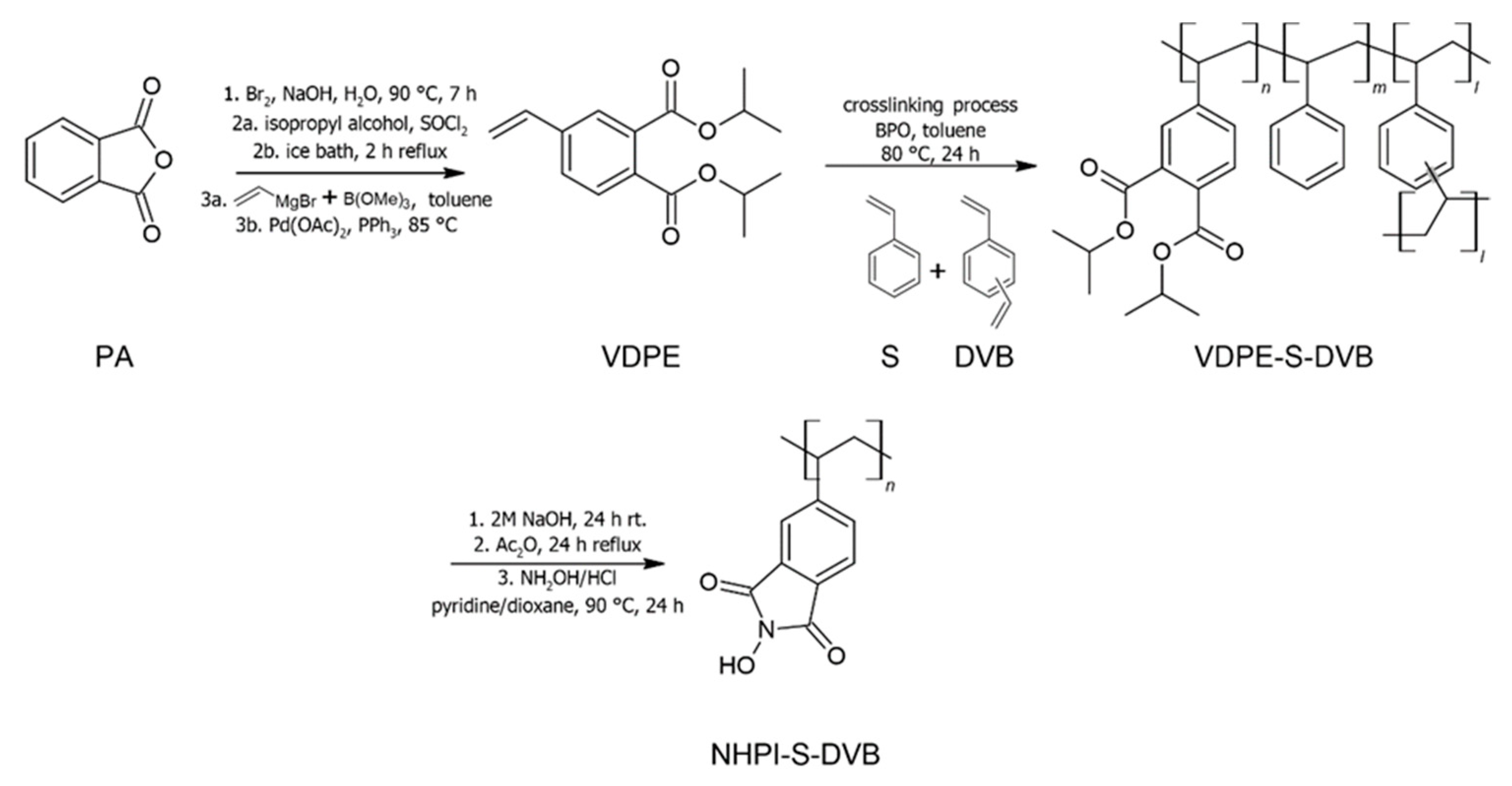

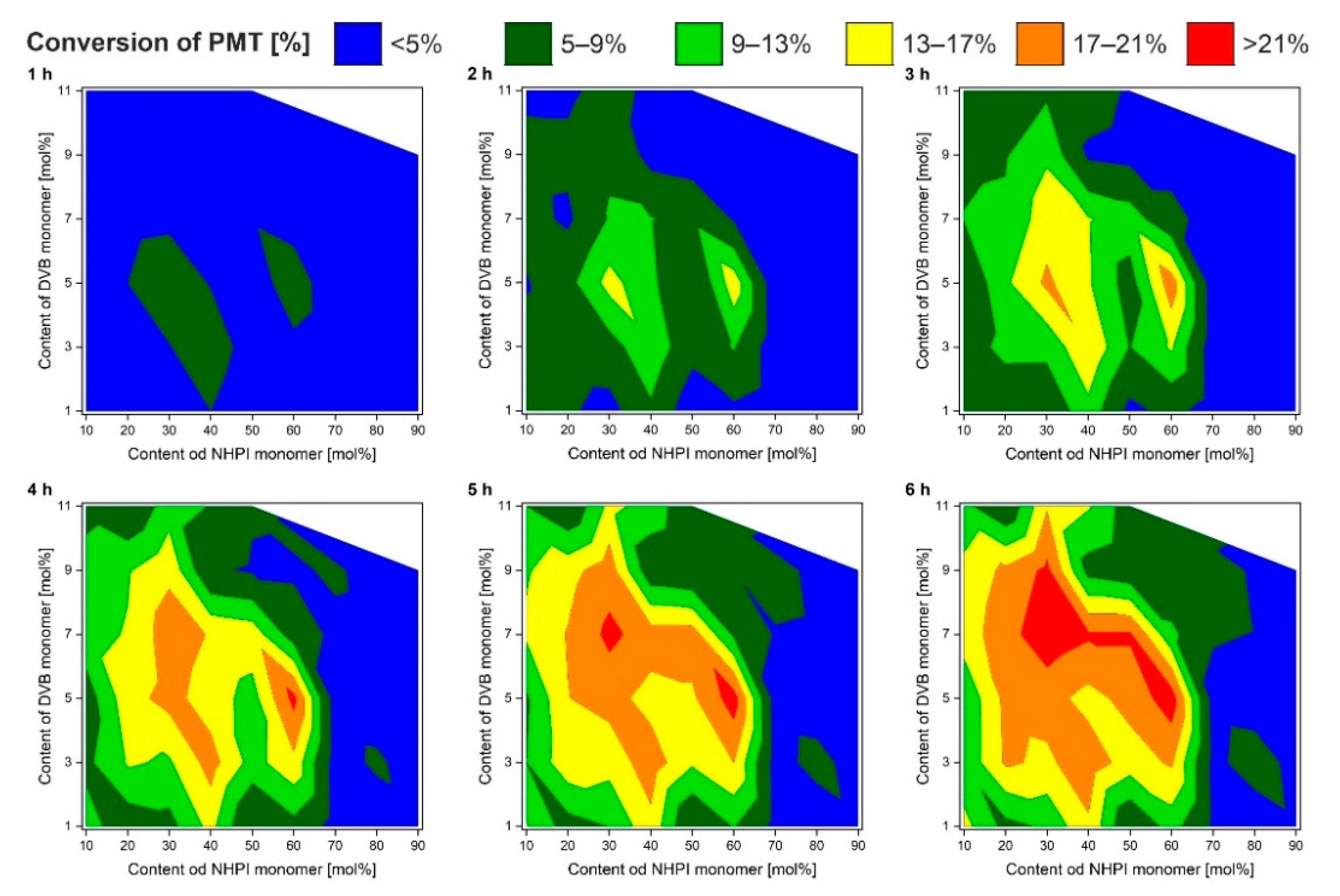

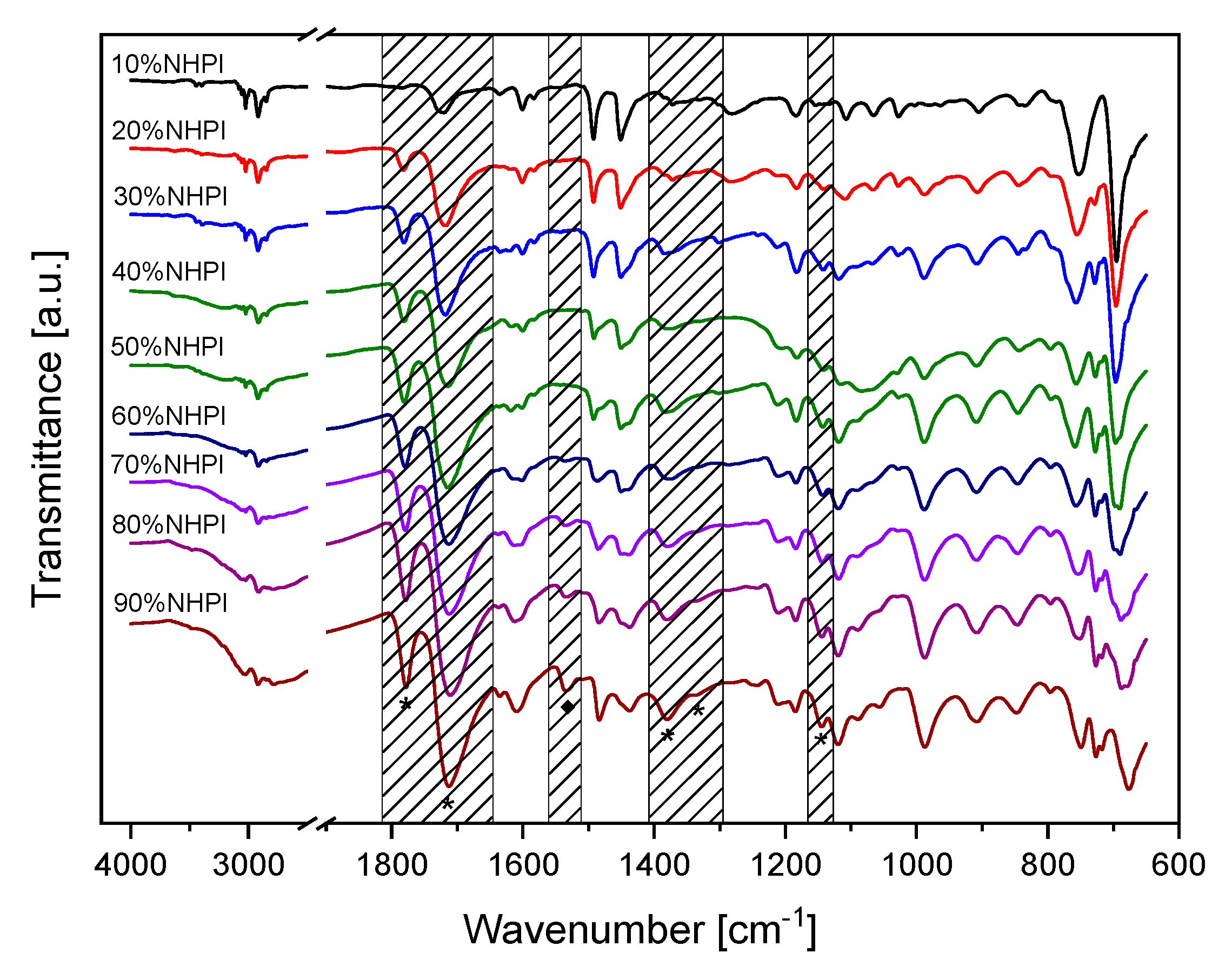
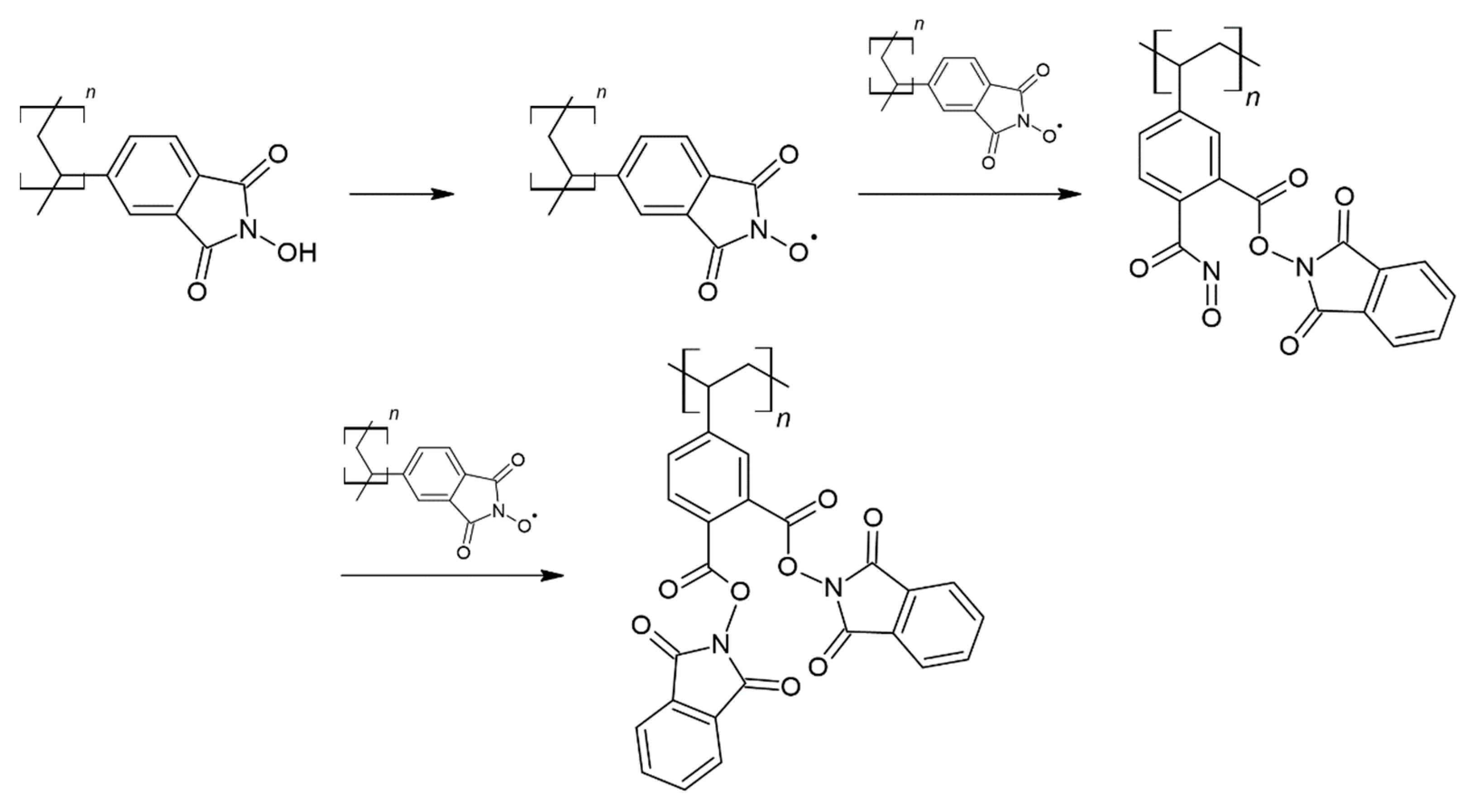
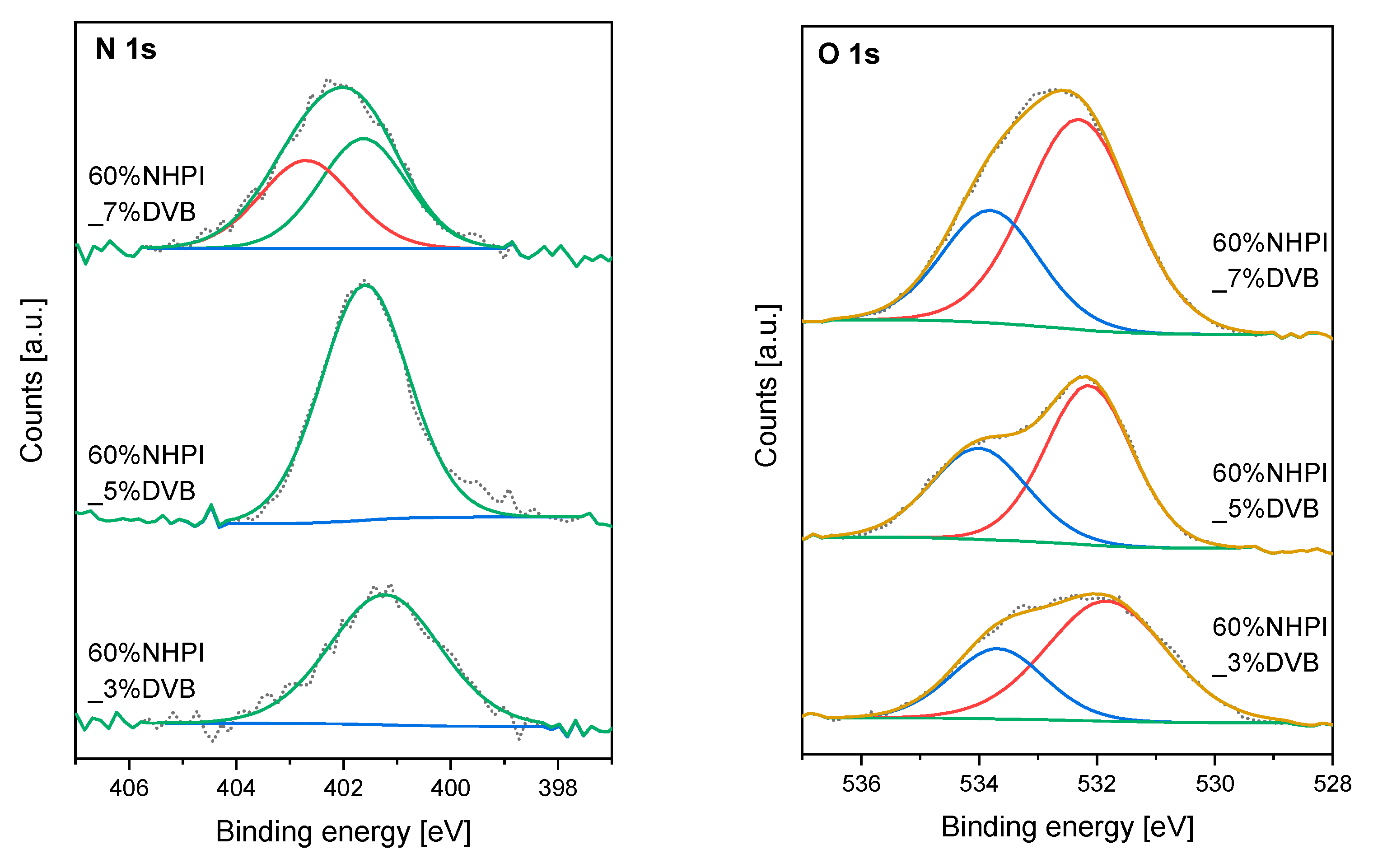

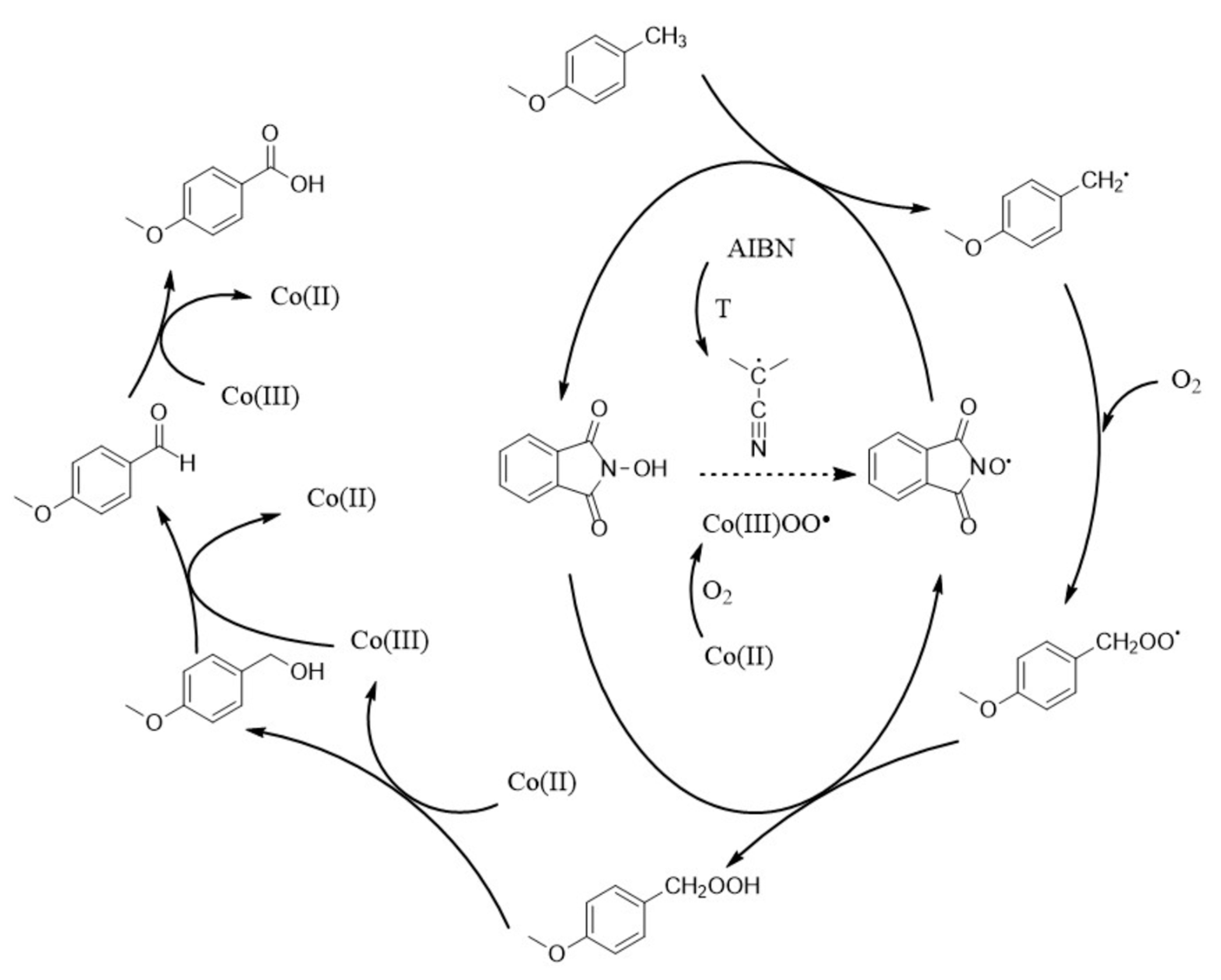


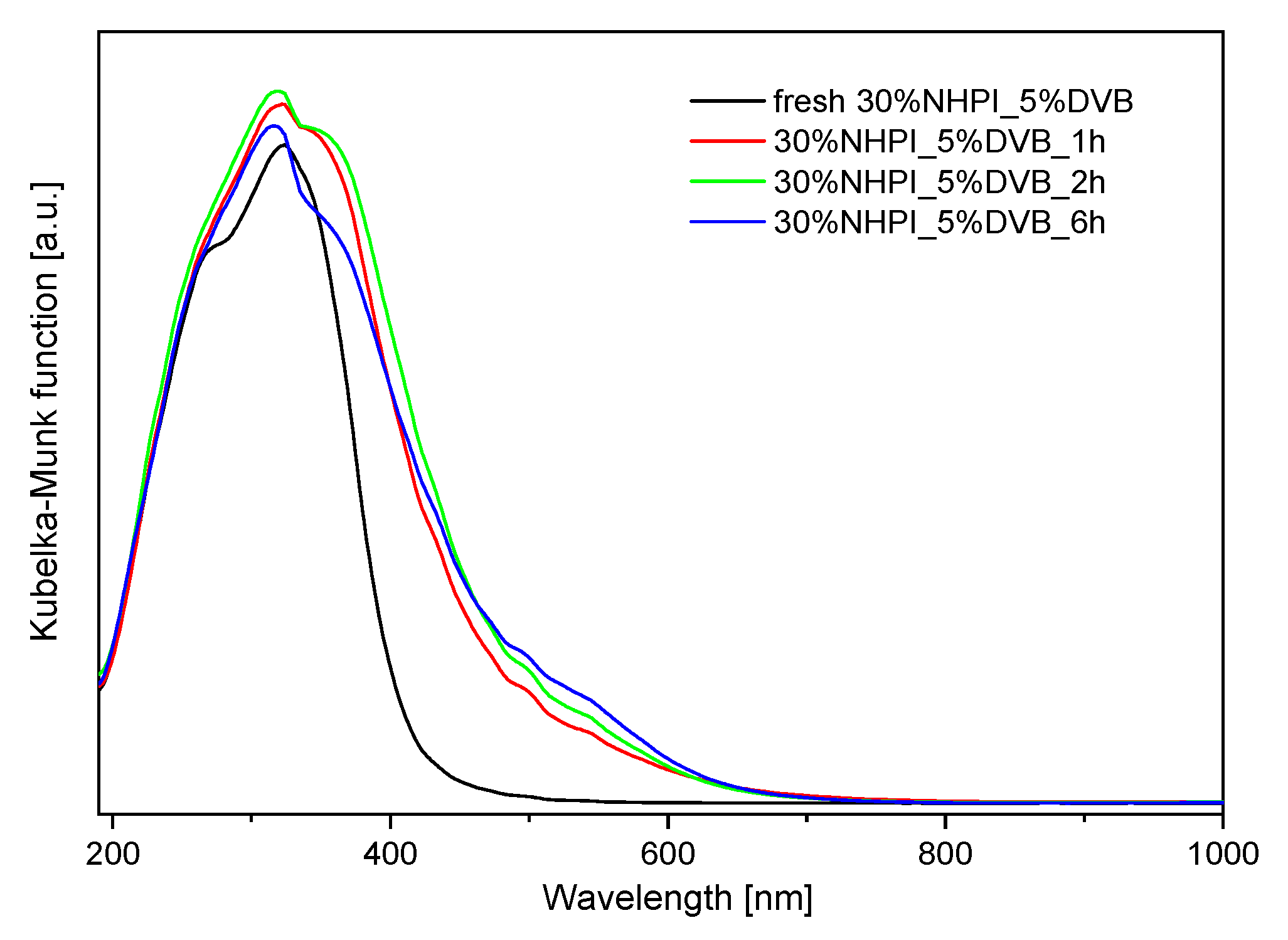
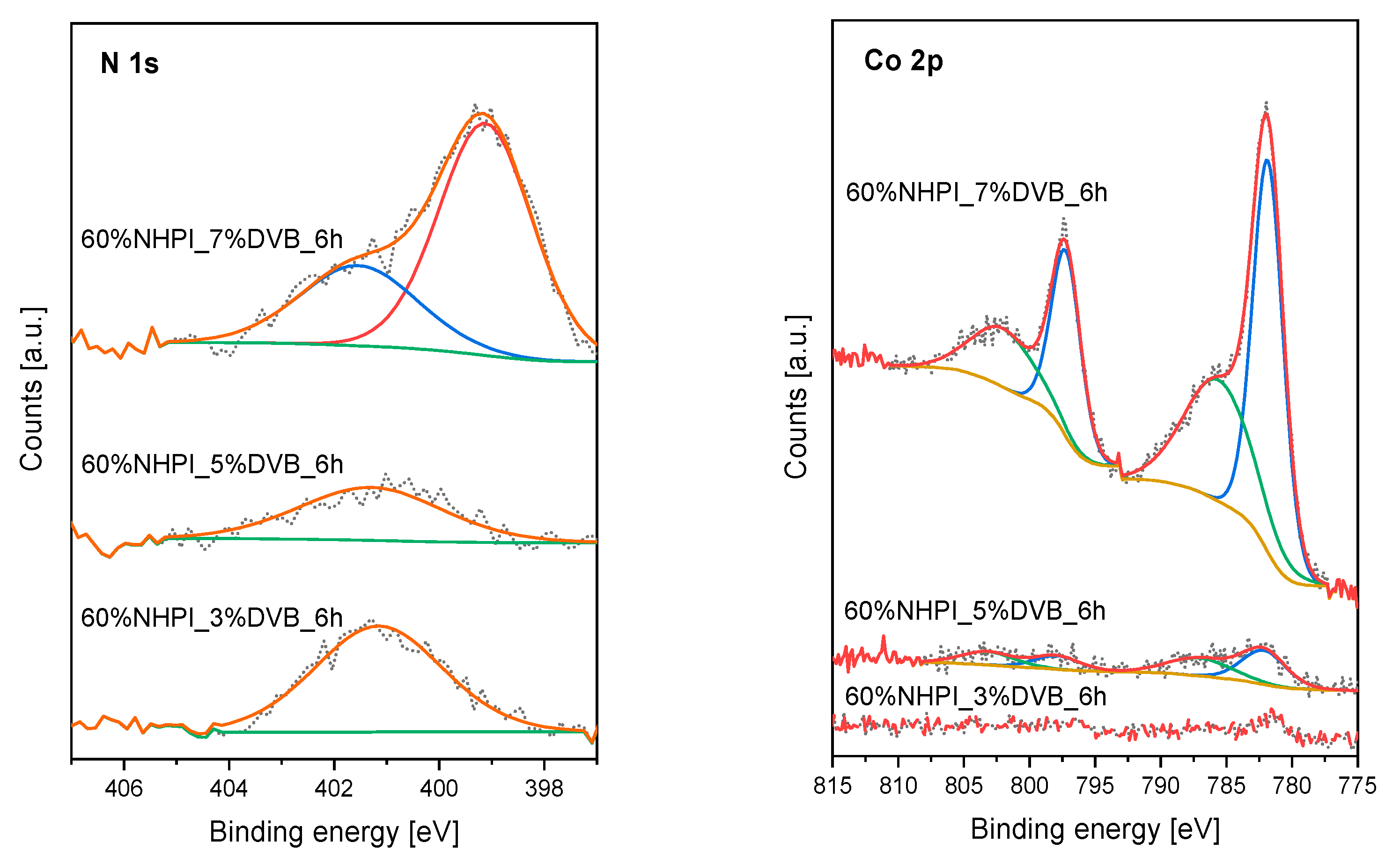
| Mol% of DVB | mol% of NHPI | ||||||||
|---|---|---|---|---|---|---|---|---|---|
| 10 | 20 | 30 | 40 | 50 | 60 | 70 | 80 | 90 | |
| 1 | 14.4 (2.31) | 7.4 (1.24) | 9.7 (1.56) | 16.4 (2.64) | 4.4 (0.71) | 10.8 (1.74) | 3.1 (0.49) | 0.7 (0.11) | 3.1 (0.50) |
| 3 | 9.9 (1.59) | 17.6 (2.83) | 16.3 (2.62) | 19.3 (3.11) | 15.1 (2.44) | 17.5 (2.82) | 2.7 (0.43) | 6.5 (1.05) | 2.3 (0.37) |
| 5 | 9.8 (1.58) | 18.0 (2.90) | 18.5 (2.98) | 15.6 (2.52) | 18.4 (2.96) | 23.3 (3.75) | 2.1 (0.34) | 1.4 (0.23) | 1.0 (0.16) |
| 7 | 14.9 (2.40) | 19.5 (3.14) | 23.6 (3.81) | 21.6 (3.48) | 21.5 (3.47) | 10.0 (1.61) | 4.5 (0.73) | 3.8 (0.62) | 2.0 (0.32) |
| 9 | 14.1 (2.27) | 17.9 (2.88) | 22.0 (3.54) | 7.3 (1.18) | 5.8 (0.93) | 5.2 (0.84) | 7.6 (1.22) | 2.9 (0.46) | 2.2 (0.36) |
| 11 | 10.2 (1.64) | 5.0 (0.81) | 16.6 (2.68) | 13.4 (2.15) | 6.5 (1.05) | n.m. | n.m. | n.m. | n.m. |
| Mol% of DVB | mol% of NHPI | ||||||||
|---|---|---|---|---|---|---|---|---|---|
| 10 | 20 | 30 | 40 | 50 | 60 | 70 | 80 | 90 | |
| 1 | 0.91 | 0.64 | 1.96 | 2.83 | 4.51 | 4.37 | 5.44 | 6.46 | 5.06 |
| 3 | 0.58 | 1.07 | 1.60 | 2.22 | 2.48 | 3.23 | 3.69 | 3.90 | 3.91 |
| 5 | 0.48 | 1.21 | 2.84 | 3.19 | 3.23 | 3.78 | 4.55 | 4.66 | 5.89 |
| 7 | 0.61 | 1.29 | 1.74 | 2.14 | 2.09 | 3.58 | 3.61 | 3.85 | 4.12 |
| 9 | 0.58 | 1.23 | 1.66 | 2.19 | 2.53 | 2.92 | 3.27 | 3.67 | 3.90 |
| 11 | 1.34 | 1.45 | 1.11 | 2.46 | 2.77 | n.m. | n.m. | n.m. | n.m. |
| Catalyst | Reaction Conditions | Substrate to Oxidation | Conversion [%] | Ref. |
|---|---|---|---|---|
| NHPI30-co-S63-co-DVB7 | 80 °C, 1 atm, 6 h, no solvent | p-methoxytoluene (15.8 mmol) | 23.6 | This work |
| NHPI immobilized onto polystyrene resins by amide bond (100 mg) | 80 °C, 1 atm, 6 h, AcOH (10 mL) | p-methoxytoluene (5 mmol) | 8.3 | [19] |
| NHPI immobilized onto polystyrene resins by ester bond (100 mg) | 80 °C, 1 atm, 6 h, AcOH (10 mL) | p-methoxytoluene (5 mmol) | 6.7 | [19] |
| NHPI immobilized onto glycidyl methacrylate (GMA) and methyl methacrylate (MMA) copolymers (1 g) | 100 °C, 1 atm, 25 h, AcOH (30 mL) | ethylbenzene (8 mmol) | 20.1 | [65] |
| N,N-dihydroxypyromellitimide (NDHPI) immobilized on SBA-15 (2 mol%) | 90 °C, 1.6 MPa, 7 h, MeCN (5 mL) | toluene (55 mmol) | 14.8 | [38] |
Publisher’s Note: MDPI stays neutral with regard to jurisdictional claims in published maps and institutional affiliations. |
© 2021 by the authors. Licensee MDPI, Basel, Switzerland. This article is an open access article distributed under the terms and conditions of the Creative Commons Attribution (CC BY) license (https://creativecommons.org/licenses/by/4.0/).
Share and Cite
Berniak, T.; Łątka, P.; Rokicińska, A.; Sidor, K.; Kuśtrowski, P. Selective Aerobic Oxidation of P-Methoxytoluene by Co(II)-Promoted NHPI Incorporated into Cross-Linked Copolymer Structure. Catalysts 2021, 11, 1474. https://doi.org/10.3390/catal11121474
Berniak T, Łątka P, Rokicińska A, Sidor K, Kuśtrowski P. Selective Aerobic Oxidation of P-Methoxytoluene by Co(II)-Promoted NHPI Incorporated into Cross-Linked Copolymer Structure. Catalysts. 2021; 11(12):1474. https://doi.org/10.3390/catal11121474
Chicago/Turabian StyleBerniak, Tomasz, Piotr Łątka, Anna Rokicińska, Karol Sidor, and Piotr Kuśtrowski. 2021. "Selective Aerobic Oxidation of P-Methoxytoluene by Co(II)-Promoted NHPI Incorporated into Cross-Linked Copolymer Structure" Catalysts 11, no. 12: 1474. https://doi.org/10.3390/catal11121474
APA StyleBerniak, T., Łątka, P., Rokicińska, A., Sidor, K., & Kuśtrowski, P. (2021). Selective Aerobic Oxidation of P-Methoxytoluene by Co(II)-Promoted NHPI Incorporated into Cross-Linked Copolymer Structure. Catalysts, 11(12), 1474. https://doi.org/10.3390/catal11121474







